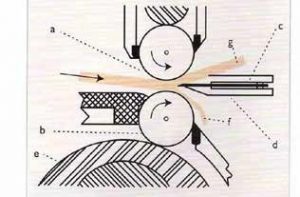
. Therefore, the skin of animals is not uniform in terms of thickness and texture in all its parts. The skin of live animals needs to be stretched much more than the back of the animal during movement in some parts Split leather, such as the lower abdomen. Therefore, the lower abdomen should be more elastic, while the back of the animal should be thicker and denser and less stretched.
The skins are also not uniform in thickness. The lower abdomen and legs are much thinner than the back and neck. The thickness of the raw cow skin in the lower abdomen and dorsal region varies from 3mm to 8mm, while in the case of fattening calves it is between 4mm and 12mm. If a material with this non-uniformity in thickness becomes leather, it can rarely be used in the production of leather goods, including shoes. Therefore, it is necessary to separate the excess material from the back of the leather to obtain a skin of the same thickness to produce the desired leather. The materials separated from the back of the leather can also be completed and used as split leather.

The first step in the tanning process is lime, which is done to remove hair. This causes the leaf-like structure of the skin to swell and open and separate, making it prone to smoother and more uniform. The next step is to remove unnecessary tissue from the back of the skin. Of course, it is necessary to perform this operation more carefully in the extremities of the animal’s body, such as the lower abdomen, legs and neck.
The next step is to peel the skin in order to achieve the desired thickness. The skin is then limed to remove the remaining components of the liming process. The thickness of the finished leather for the production of shoes should be between 1.8 to 2 mm, so obviously a large amount of leather material must be removed. Leathers are bought on the basis of their weight, while finished leathers are sold on the basis of area (square feet), so tanners should turn the skin into marketable materials as much as possible. In fact, this is because the extra materials are turned into split leather with subsequent treatments, and they have the ability to be used to produce various consumer products, including a variety of shoes, and especially the production of suede for shoe soles.
The main problem with the finished split is that it has less physical strength than real leather, because the leather has a denser surface and a more durable fibrous structure remains beneath it.
Since the fibrous structure of the lower abdomen and legs is in the weakest and most elongated position, the splints should be carefully removed so that their weak parts are separated and only the best parts remain around the dorsal area. The result is a final product that, after the final peel and final thickness, is called the “backpack.”
Split leather produced by the brave leather industry also has many advantages, including its easy and cost-effective cutting, as well as its greater elasticity and thus easier work on it. In fact, the last feature mentioned is that it does not stretch too much in the production process. In addition, by precisely controlling the adjusting machines and using a booster on the back of the leather, it can be prevented from stretching too much.
In general, in a place where leather is considered tensile strength, the better quality of the fibrous structure of the primary skin will produce better quality split leather, and as a result, its tensile strength will be higher. In terms of thickness, it is generally recommended to use thick split as much as possible. Completing the suede on the split makes its surface very soft.
Splits with an artificial face layer (usually containing a layer of polyurethane skin) will be more durable. In the leather factory, slate can be added to the back of the suede split, in which case it is called suede moss. This slate can contain dough made from Irish moss or hardeners for leather goods.

Using a leather enhancer behind the split leather can increase its tensile strength and help control the amount of tension and maintain its shape. This balances its properties. For a long time, a type of cotton taro fabric was a traditional choice for use as reinforcement, because the delicate fuzz coming out of the fabric created resistance as well as a feeling of relative softness. There is a better choice available today that is a cotton or non-woven loop fabric made of polyester, polypropylene and nylon that is suitable for end use (especially in the case of boots and shoes that require initial molding).
Split leather edges should be reinforced with either an edge fastener or edge tape on the folded edges. There are actually two distinct types of edge tape. One type is the thin braids made of polyester or nylon, which are used when folding the edge with heat inside. This type is very convenient to use. Another type is wide adhesive coated tapes that are used before folding and can be subjected to initial stress to neutralize the tension on the folding machine.
Dalir Leather Industries, a manufacturer and supplier of various types of split leather in different colors and with high thicknesses, is ready to serve you dear ones.
Author: Ms. Maryam Semsarha
Expert and researcher of the Institute of Standards